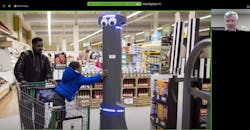The first session for RIA’s Robotics Week featured a roundtable of robotics experts from various industry verticals. The panelists included:
- Martin Buehler, CTO of Wavemaker Labs
- Marty Linn, director, Manufacturing Automation Center, Tyson Food Products
- Aaron Prather, senior technical advisor, FedEx
- Tim Rowland, CEO, Badger Technologies
These panelists focused on unique challenges and advancements that the robotics industry will face moving forward in their respective verticals. Robert Huschka, director of Education Strategies for the Association for Advancing Automation, asked Rowland to provide advice for robotics implementation in non-traditional applications, such as in the retail industry.
“One of the biggest things that was a vision from the beginning was not to require any infrastructure,” Rowland said. “At this point, [the robots] are charging from a standard power outlet.”
He discussed how a robot deployment turned into more of what he called “celebrity week” in which a robot was introduced into an environment but could get no work done from all the attention it received from the general public. His company began attaching googly eyes to the robot to make it more approachable—and more photogenic.
“It just makes you aware of what you have to do to introduce some pretty high-tech into, literally, a pedestrian environment,” he said. “Doing things like lights and softening the colors and adding googly eyes…that’s a lesson we learned.”
Rowland also highlighted the importance of the robot already having all software and hardware needed to perform tasks like inventory, sweeping, mopping and disinfection while maintaining the ability to avoid the pedestrians.
Linn, speaking for a large portion of the food industry, was able to speak to human-robot interaction in a different way than Rowland. Linn’s position focused on the workforce in the wake of the COVID-19 pandemic. “The impact [of COVID] has really exacerbated the problems that we had to begin with,” he said.
Prather echoed the importance of robotics—especially in the age of COVID-19—in the logistics and warehousing industry. “It is crystal clear that e-commerce is not going away,” he said. “Even as we deploy these automated systems, we can’t keep up with the demand.”
Prather also discussed that if a company is building a new logistics facility, it would be easy to create an environment conducive for automation and robots. The issue is implementing robots into a facility not already designed for it.
“There are billions if not trillions of dollars of infrastructure around the world in logistics,” he said. “It’s going to be tricky to figure out how you’re going to upgrade those while keeping the operation going.”
Of course, the restaurant industry is an excellent example of how robots can be implemented, but the environment isn’t built for that type of automation. Buehler discussed this challenge and described an example in which a robot manufacturer couldn’t mass-customize but must incorporate robots in places they’d generally fit.
“Automating and bringing more data to the industry is just as important to the beginning of food as it is for the whole chain,” he said.
The conversation wrapped up with an important, yet controversial design question: Should robots have a face?
Rowland admitted that he has seen a pushback if a robot looked too humanoid. “I think there’s a crowd reaction of ‘that’s too far—for now,’” he said. He further discussed that Badger’s success was bred from an almost-comical approach when they began placing googly eyes on the robots.
FedEx is known for robot implementation in its distribution centers, and Prather gave some insight into the workforce-robot relationship within logistics. That relationship began with naming the robots. “We allow the employees to name their robots,” he said. “and that has actually made the robots part of the team.”
The panelists agreed that the general public’s perception of robots is becoming more and more important. So, should robots have a face? Tweet us your opinion at @MachineDesign.
About the Author

Marie Darty
Group Multimedia Director, Engineering & Manufacturing
Marie Darty is a digital media professional currently serving as the group multimedia director for the Manufacturing & Engineering Group at Endeavor Business Media. A graduate of Jacksonville State University, she earned her Bachelor of Arts in digital communication with a concentration in digital journalism in December 2016. In her current role, she leads the strategy and production of multimedia content, overseeing video series planning and editing. Additionally, she oversees podcast production and marketing of multimedia content.

